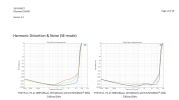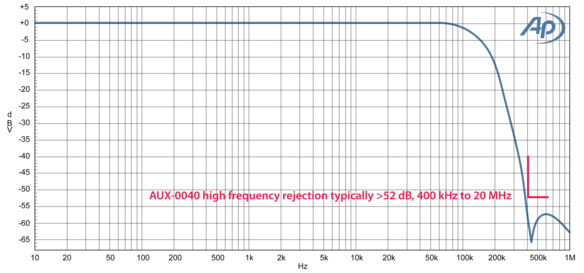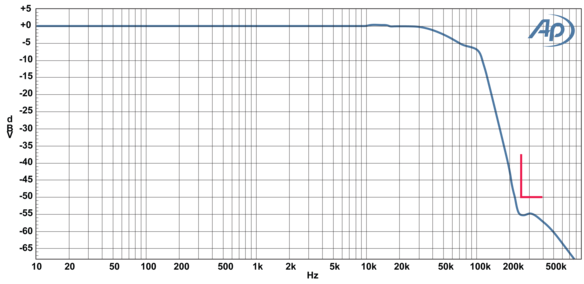I don't look at the regulation from an engineering point of view but a legal one. Viewing from that perspective then the regulation means what it says all frequencies from 20hz-20khz at 5 minutes. Not 1, 3, 10 or 32 which is why under the petition to reopen the FTC is being asked for clarification or guidance on these tests as well as whether the regulation applies retroactively.
-
Welcome to ASR. There are many reviews of audio hardware and expert members to help answer your questions. Click here to have your audio equipment measured for free!
- Forums
- Audio, Audio, Audio!
- Amplifiers, Phono preamp, and Analog Audio Review
- Stereo and Multichannel Amplifier Reviews
You are using an out of date browser. It may not display this or other websites correctly.
You should upgrade or use an alternative browser.
You should upgrade or use an alternative browser.
Purifi 1ET400A with linear PSU tested to comply with FTC rule
- Thread starter pma
- Start date
- Status
- Not open for further replies.
Sokel
Master Contributor
- Joined
- Sep 8, 2021
- Messages
- 9,592
- Likes
- 10,288
pma tests here are good for my rule except my tests freqs would be 20Hz,100Hz,1KHz,6.6KHz
The 20Hz one may seem low for music but if it can do that it can also do 30's which is my concern and as far as i can see I'll stick to full-bridge amps as they seem to tame (my) lows a little better no matter the power (apart the actual power of course) .
The 20Hz one may seem low for music but if it can do that it can also do 30's which is my concern and as far as i can see I'll stick to full-bridge amps as they seem to tame (my) lows a little better no matter the power (apart the actual power of course) .
Last edited:
- Thread Starter
- #24
pma tests here are good for my rule except my tests freqs would be 20Hz,100Hz,1KHz,6.6KHz
The 20Hz one may seem low for music but if it can do that it can also do 30's which is my concern and as far as i can see I'll stick to full-brigde amps as they seem to tame (my) lows a little better no matter the power (apart the actual power of course) .
Test frequencies may be change according to DUT behaviour. 20Hz, 1kHz and 20kHz I use always, anything in between may be added if there is a good reason.
Sokel
Master Contributor
- Joined
- Sep 8, 2021
- Messages
- 9,592
- Likes
- 10,288
6.6KHz is an interesting one for all amps as apples to apples as it's H2 and H3 are measured even with the limited 20Hz-20KHz or filtered BW which we use for class D.Test frequencies may be change according to DUT behaviour. 20Hz, 1kHz and 20kHz I use always, anything in between may be added if there is a good reason.
Edit:for example,icepower promised us great improvement there with their new Conductor,and it seems they delivered:

link
(someone here must cross-check this! )
Last edited:
- Thread Starter
- #26
I do not use the 20 kHz LPF filter when testing class D amplifiers. Fortunately, E1DA Cosmos ADC does not suffer from input slew rate problem and measures THD < -120 dB even without that filter. I find measuring THD and also THD+N with 20kHz limited bandwidth as pointless for signal frekvencies >= 5kHz. HF distortion and noise is interesting from engineering point. I do not say it is audible, but if we stick with audibility of nonlinear distortion, then we may close the whole distortion measurement chapter.6.6KHz is an interesting one for all amps as apples to apples as it's H2 and H3 are measured even with the limited 20Hz-20KHz or filtered BW which we use for class D.
I was expecting a comment from @restorer-john ?
Seems like there is some confusion with respect to AES 20 kHz filter. It does NOT have 20 kHz of bandwidth. Spec mandates that it be flat in that bandwidth. Given that, the actual cut off frequency is far higher. Here are the AP measurements for the AUX-0040 that I use:I do not use the 20 kHz LPF filter when testing class D amplifiers. Fortunately, E1DA Cosmos ADC does not suffer from input slew rate problem and measures THD < -120 dB even without that filter. I find measuring THD and also THD+N with 20kHz limited bandwidth as pointless for signal frekvencies >= 5kHz.

As seen, it is nearly flat to 100 kHz which is plenty of bandwidth to use for harmonic distortion. Their 20 kHz one is not as extended but even there, the bandwidth goes much higher than 20 kHz:

As we see, it is only down a couple of dBs at 50 kHz. So no problem in capturing harmonics with a 45 kHz bandwidth.
As to E1DA not needing it, when it has an autoscalar front-end with ability to measure somem 155 volts input, then come and brag about it. Until then, AP also does quite well without the filter. The ultrasonic noise mostly confuses that auto-scalar than other artifacts. Here is the Purifi reference design FFT without the filter:
As you see, spikes are easily visible down to -120 dB. If you used a software THD analyzer as you are doing with E1DA you could also run the AP without the filter. AP's dedicated THD analyzer is not as sophisticated so may get confused with ultrasonic noise.
KSTR
Major Contributor
Maybe Pavel meant the 20kHz brickwall analog filter (S-AES17) as present in the previous generation of APs?
That one would compromise THD(+N) quite a bit at higher frequencies.

And/or the original 25kHz version of the AUX-00xx filters?
While not as steep as the above filter some effect would be seen on harmonics falling above 20kHz.

That one would compromise THD(+N) quite a bit at higher frequencies.
And/or the original 25kHz version of the AUX-00xx filters?
While not as steep as the above filter some effect would be seen on harmonics falling above 20kHz.
- Thread Starter
- #31
Yes. Strict 20 kHz BW limiting is used to create nicely looking THD+N plots (however pointless and irrelevant) of class D amplifiers, including the Purifi. Below is the proof, including AES17 mention.Maybe Pavel meant the 20kHz brickwall analog filter (S-AES17) as present in the previous generation of APs?
That one would compromise THD(+N) quite a bit at higher frequencies.
To @amirm
Would you mind posting the graphs like the one above (switching frequency amplitude) with calibrated Y axis? Like dBV, V, anything. The plot in dBrA does not allow to read the switching frequency amplitude, it is important to know.
Last edited:
HaveMeterWillTravel
Senior Member
As someone who has professionally tested electronics to a multitude of standards over the years, the FTC's standard has less information than the marketing blurb from IEC, EN, MIL-STD, ANSI, AMSE put out about their standards.
HaveMeterWillTravel
Senior Member
How do you propose to measure THD using white noise as the test stimuli in a practical manner?I don't look at the regulation from an engineering point of view but a legal one. Viewing from that perspective then the regulation means what it says all frequencies from 20hz-20khz at 5 minutes. Not 1, 3, 10 or 32 which is why under the petition to reopen the FTC is being asked for clarification or guidance on these tests as well as whether the regulation applies retroactively.
I don't look at the regulation from an engineering point of view but a legal one. Viewing from that perspective then the regulation means what it says all frequencies from 20hz-20khz at 5 minutes. Not 1, 3, 10 or 32 which is why under the petition to reopen the FTC is being asked for clarification or guidance on these tests as well as whether the regulation applies retroactively.
Nothing in the regulation says every frequency needs to be tested. It's up to the manufacturer to decide what frequencies from an engineering view allows them to make a factual statement. In an enforcement action it's up to the FTC to prove the amplifier is incapable of meeting the stated spec.
MaxwellsEq
Major Contributor
- Joined
- Aug 18, 2020
- Messages
- 3,059
- Likes
- 5,208
The regulation requires all frequencies and measured with distortion.Nothing in the regulation says every frequency needs to be tested. It's up to the manufacturer to decide what frequencies from an engineering view allows them to make a factual statement
- Thread Starter
- #36
Interpretation is to be wise and making sense. There is an infinite number of frequencies between 20Hz and 20kHz, depending on smallest frequency resolution used. Again, only a nit picking, posts for posts, without practical sense.The regulation requires all frequencies and measured with distortion.
Geert
Major Contributor
- Joined
- Mar 20, 2020
- Messages
- 2,240
- Likes
- 4,507
Nothing in the regulation says every frequency needs to be tested. It's up to the manufacturer to decide what frequencies from an engineering view allows them to make a factual statement. In an enforcement action it's up to the FTC to prove the amplifier is incapable of meeting the stated spec.
The rated power output is measured in compliance with the standard test conditions in § 432.3; Any power level from 250 mW to the rated power shall be obtainable at all frequencies within the rated power band of 20 Hz to 20 kHz without exceeding 1.0% of total harmonic distortion plus noise (THD+N) at an impedance of 8 ohms after input signals at said frequencies have been continuously applied at full rated power for not less than five (5) minutes
Don't know what a signal that contains all frequencies at full power continuously for 5 minutes looks like, and how you measure THD for such a signal. White noise doesn't comply (doesn't guaranty it contains all frequencies at full power continously).
KSTR
Major Contributor
Repeated medium fast log sweep as used for IR measurement would apply, minimum crest factor. If you need it completely gapless, Newman sweep would be a solution, which is a form of periodic white noise with phases set up to result in a sort of endless sweep with a very low crest factor.
And then we have FSAF: https://www.audiosciencereview.com/...nd-adaptive-filtering-fsaf-measurement.58697/
And then we have FSAF: https://www.audiosciencereview.com/...nd-adaptive-filtering-fsaf-measurement.58697/
- Thread Starter
- #39
Yes. It is only a misunderstanding and misinterpretation based on lack of knowledge in the field.Don't know what a signal that contains all frequencies at full power continuously for 5 minutes looks like, and how you measure THD for such a signal. White noise doesn't comply (doesn't guaranty it contains all frequencies at full power continously).
- Thread Starter
- #40
Yes but they will argue with 5 minutes at the fixed frequency. The debate is pointless, as most debates.Medium fast log sweep as used for IR measurement would apply, minimum crest factor
- Status
- Not open for further replies.
Similar threads
- Replies
- 82
- Views
- 14K
- Locked
- Replies
- 888
- Views
- 110K
- Replies
- 40
- Views
- 18K
- Replies
- 261
- Views
- 41K
- Replies
- 139
- Views
- 64K
